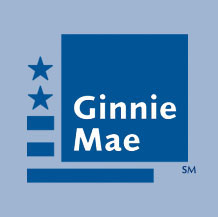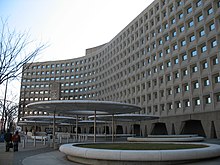
The United States secretary of housing and urban development is the head of the United States Department of Housing and Urban Development, a member of the president's Cabinet, and thirteenth in the presidential line of succession. The post was created with the formation of the Department of Housing and Urban Development on September 9, 1965, by President Lyndon B. Johnson's signing of into law. The department's mission is "to increase homeownership, support community development and increase access to affordable housing free from discrimination."

The Federal Housing Administration (FHA), also known as the Office of Housing within the Department of Housing and Urban Development (HUD), is a United States government agency founded by President Franklin Delano Roosevelt, established in part by the National Housing Act of 1934. Its primary function is to provide insurance for mortgages originated by private lenders for various types of properties, including single-family homes, multifamily rental properties, hospitals, and residential care facilities. FHA mortgage insurance serves to safeguard these private lenders from financial losses. In the event that a property owner defaults on their mortgage, FHA steps in to compensate the lender for the outstanding principal balance.

The United States Department of Transportation is one of the executive departments of the U.S. federal government. It is headed by the secretary of transportation, who reports directly to the president of the United States and is a member of the president's Cabinet.

Redlining is a discriminatory practice in which financial services are withheld from neighborhoods that have significant numbers of racial and ethnic minorities. Redlining has been most prominent in the United States, and has mostly been directed against African-Americans. The most common examples involve denial of credit and insurance, denial of healthcare, and the development of food deserts in minority neighborhoods.

The Government National Mortgage Association (GNMA), or Ginnie Mae, is a government-owned corporation of the United States Federal Government within the Department of Housing and Urban Development (HUD). It was founded in 1968 and works to expand affordable housing by guaranteeing housing loans (mortgages) thereby lowering financing costs such as interest rates for those loans. It does that through guaranteeing to investors the on-time payment of mortgage-backed securities (MBS) even if homeowners default on the underlying mortgages and the homes are foreclosed upon.
A reverse mortgage is a mortgage loan, usually secured by a residential property, that enables the borrower to access the unencumbered value of the property. The loans are typically promoted to older homeowners and typically do not require monthly mortgage payments. Borrowers are still responsible for property taxes or homeowner's insurance. Reverse mortgages allow older people to immediately access the home equity they have built up in their homes, and defer payment of the loan until they die, sell, or move out of the home. Because there are no required mortgage payments on a reverse mortgage, the interest is added to the loan balance each month. The rising loan balance can eventually grow to exceed the value of the home, particularly in times of declining home values or if the borrower continues to live in the home for many years. However, the borrower is generally not required to repay any additional loan balance in excess of the value of the home.

An FHA insured loan is a US Federal Housing Administration mortgage insurance backed mortgage loan that is provided by an FHA-approved lender. FHA mortgage insurance protects lenders against losses. They have historically allowed lower-income Americans to borrow money to purchase a home that they would not otherwise be able to afford. Because this type of loan is more geared towards new house owners than real estate investors, FHA loans are different from conventional loans in the sense that the house must be owner-occupant for at least a year. Since loans with lower down-payments usually involve more risk to the lender, the home-buyer must pay a two-part mortgage insurance that involves a one-time bulk payment and a monthly payment to compensate for the increased risk. Frequently, individuals "refinance" or replace their FHA loan to remove their monthly mortgage insurance premium. Removing mortgage insurance premium by paying down the loan has become more difficult with FHA loans as of 2013.

Nehemiah Corporation of America is a non-profit organization based in Sacramento, California specializing in homeownership, affordable housing and community development. It started in 1994 as a small organization, but grew to prominence later in the 1990s after it developed a program that allowed home buyers to make down payments on their purchases using funds that were derived from the home sellers. This program, the Nehemiah Program, became popular and was widely emulated, giving birth to what came to be known as the seller-funded down-payment assistance industry. The industry attracted criticism from U.S. federal agencies and was ultimately shut down in 2008 by a change in federal law.

The Housing and Community Development Act of 1974 is a United States federal law that, among other provisions, amended the Housing Act of 1937 to create Section 8 housing, authorizes "Entitlement Communities Grants" to be awarded by the United States Department of Housing and Urban Development, and created the National Institute of Building Sciences. Under Section 810 of the Act the first federal Urban Homesteading program was created.

The National Housing Act of 1934, H.R. 9620, Pub. L.Tooltip Public Law 73–479, 48 Stat. 1246, enacted June 27, 1934, also called the Better Housing Program, was part of the New Deal passed during the Great Depression in order to make housing and home mortgages more affordable. It created the Federal Housing Administration (FHA) and the Federal Savings and Loan Insurance Corporation (FSLIC).

The Assistant Secretary for Housing, who also carries the title Federal Housing Commissioner, is a position within the United States Department of Housing and Urban Development. The Assistant Secretary is responsible for overseeing the $400 billions Federal Housing Administration insurance portfolio and the Department of Housing and Urban Development's regulatory responsibilities in the areas of the Real Estate Settlement Procedures Act, the housing mission of Fannie Mae and Freddie Mac, and the manufactured housing industry.

The American Housing Act of 1949 was a landmark, sweeping expansion of the federal role in mortgage insurance and issuance and the construction of public housing. It was part of President Harry Truman's program of domestic legislation, the Fair Deal.
FHA-Secure was a Federal Housing Administration refinancing program to help borrowers avoid foreclosure. It is similar to other FHA loan.

The United States Housing and Economic Recovery Act of 2008 was designed primarily to address the subprime mortgage crisis. It authorized the Federal Housing Administration to guarantee up to $300 billion in new 30-year fixed rate mortgages for subprime borrowers if lenders wrote down principal loan balances to 90 percent of current appraisal value. It was intended to restore confidence in Fannie Mae and Freddie Mac by strengthening regulations and injecting capital into the two large U.S. suppliers of mortgage funding. States are authorized to refinance subprime loans using mortgage revenue bonds. Enactment of the Act led to the government conservatorship of Fannie Mae and Freddie Mac.

In the United States, subsidized housing is administered by federal, state and local agencies to provide subsidized rental assistance for low-income households. Public housing is priced much below the market rate, allowing people to live in more convenient locations rather than move away from the city in search of lower rents. In most federally-funded rental assistance programs, the tenants' monthly rent is set at 30% of their household income. Now increasingly provided in a variety of settings and formats, originally public housing in the U.S. consisted primarily of one or more concentrated blocks of low-rise and/or high-rise apartment buildings. These complexes are operated by state and local housing authorities which are authorized and funded by the United States Department of Housing and Urban Development (HUD). In 2020, there were one million public housing units. In 2022, about 5.2 million American households that received some form of federal rental assistance.
The Federal Housing Enterprises Financial Safety and Soundness Act of 1992. The Act established the Office of Federal Housing Enterprise Oversight (OFHEO) within the United States Department of Housing and Urban Development (HUD). It also mandated that HUD set specific goals for the government-sponsored enterprises Fannie Mae and Freddie Mac, with regard to low income and underserved housing areas.
The Helping Families Save Their Homes Act of 2009 is an enacted public law in the United States. On May 20, 2009, the Senate bill was signed into law by President Barack Obama. The stated purpose of the act, a product of the 111th United States Congress, was to allow bankruptcy judges to modify mortgages on primary residences, among other purposes; however, that provision was dropped in the Senate and is not included in the version that was eventually signed into law. In addition, the bill amends the Hope for Homeowners Program as well as provide additional provisions to help borrowers avoid foreclosure.
Housing discrimination in the United States refers to the historical and current barriers, policies, and biases that prevent equitable access to housing. Housing discrimination became more pronounced after the abolition of slavery in 1865, typically as part of Jim Crow laws that enforced racial segregation. The federal government didn't begin to take action against these laws until 1917, when the Supreme Court struck down ordinances prohibiting blacks from occupying or owning buildings in majority-white neighborhoods in Buchanan v. Warley. However, the federal government as well as local governments continued to be directly responsible for housing discrimination through redlining and race-restricted covenants until the Civil Rights Act of 1968.

The Housing and Urban Development Act of 1968, Pub. L.Tooltip Public Law 90–448, 82 Stat. 476, enacted August 1, 1968, was passed during the Lyndon B. Johnson Administration. The act came on the heels of major riots across cities throughout the U.S. in 1967, the assassination of Civil Rights Leader Martin Luther King Jr. in April 1968, and the publication of the report of the Kerner Commission, which recommended major expansions in public funding and support of urban areas. President Lyndon B. Johnson referred to the legislation as one of the most significant laws ever passed in the U.S., due to its scale and ambition. The act's declared intention was constructing or rehabilitating 26 million housing units, 6 million of these for low- and moderate-income families, over the next 10 years.
The Housing Act of 1954, Pub. L.Tooltip Public Law 83–560, 68 Stat. 590, enacted August 2, 1954, passed during the Dwight D. Eisenhower Administration, comprised a series of amendments to the National Housing Act of 1934. Referred to within the legislation simply as the "National Housing Act", the program was managed by the Federal Housing Administration (FHA), an agency created by the 1934 Act. Previous amendments to the 1934 Act were made in 1937 and 1949.















